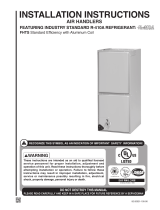
11
select an airfl ow at or near the top of the
range for that nominal capacity. For maximum
dehumidifi cation, select an airfl ow near the
middle or bottom of the range for that nominal
capacity. Additional information on humidity
control can be found in the sections labeled
“Humidistat” and “Delay Setting”.
NOTE: If coil icing is observed, the basic cooling/
heat-pump airfl ow selected may be too low.
Double-check to be sure the setting selected is
within the range shown in Table 3. Also check
to be sure the system is properly charged (see
outdoor unit Installation Instructions). If icing
continues to occur, raise the selected airfl ow
one or two steps.
When operating in the heat pump mode, a higher
basic airfl ow setting will increase the energy
effi ciency and capacity but will also decrease
the supply air temperature.
Selecting the Minimum Electric Heat
Airfl ow— The minimum electric heat airfl ow is
selected by setting switches 5 and 6. Selecting
the minimum electric heat airfl ow sets the
minimum air fl ow that will be produced whenever
electric heater kits are used. When the electric
heater kits are energized along with a heat pump,
the airfl ow may be higher depending on the basic
cooling/heat-pump airfl ow setting.
Reference Table 4 for recommended minimum
electric heat airfl ow settings. The minimum
electric heat airfl ow setting may be set higher,
but must never be set lower than the setting
shown in Table 4.
Selecting the Delay Profi le— The delay profi le
is selected by setting switches 7 and 8 (see
Table 5). Delay profi le selection controls the
start-up and shut-down characteristics of the air
handler. By varying the start-up and shut-down
characteristics of the air handler the system
can be optimized for energy effi ciency, humidity
control, and comfort.
Select “Delay A” or “Delay B” for highest energy
effi ciency. “Delay A” has a two-step “on” delay.
The blower will begin operation at 31% airfl ow
for 30 seconds. The second step operation is
75% airfl ow for 30 seconds. After the two-step
“on” delay has been completed, the blower
operation will be 100% until the thermostat
has been satisfi ed. “Delay A” also provides a
60 second “off” delay at 50% airfl ow.
“Delay B” has a single step 30 second “on”
delay at 50% airfl ow. “Delay B” also provides
air handler must be confi gured to match the unit
with the system, system options, and climatic
conditions. Once confi gured, the air handler
responds directly to the thermostat inputs, as
well as the optional humidistat (Section 6).
During normal operation, the motor will gradually
change speeds during start-up, shut down,
when thermostat inputs change, and when the
duct static pressure changes (vents closed or
opened, fi lter clogging, etc.). The air handler
is confi gured by setting the selector switches
and removing jumper connectors as directed
below. IMPORTANT! This air handler has
been designed to give the installer maximum
fl exibility to optimize system performance,
effi ciency, and comfort. Because there are
so many different ways to set up the air
handler it is important to read and follow
these directions carefully.
Determining Nominal System Capacity— In
order to select the appropriate airfl ows for the
air handler the nominal system capacity must
be known. The nominal system capacity is
always the nominal capacity of the outdoor unit.
In some cases the nominal system capacity is
not the same as the nominal capacity of the air
handler. Always refer to the nominal capacity
of the outdoor unit to determine the nominal
system capacity.
Selecting the Basic Cooling/Heat Pump
Airfl ow — The basic cooling/heat-pump airfl ow
is selected by setting switches 1 through 4
on the thermostat input board located on the
blower. All airfl ows for other modes of operation
(except electric heat) are determined by this
basic setting.
Table 3 shows the basic airfl ow values versus
the airfl ow selector switch settings. Table 3
also shows the range of basic air fl ow settings
recommended for each nominal system capacity.
“Fan Only” would deliver 50% of the selected
cooling airfl ow.
Note: The 15+ SEER variable speed air handlers
that are matched with a 2-stage cooling outdoor
unit, are programmed to operate at 75% of the
selected airfl ow while the system is in the lo-cool
mode and 100% of the selected airfl ow while
in hi-cool mode.
NOTE: The CFM values listed in the tables are
not dependent on duct static pressure. The motor
automatically compensates for changes in duct
static pressure (within the limits of the motor).
For maximum capacity and energy effi ciency,

















